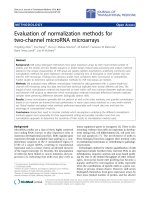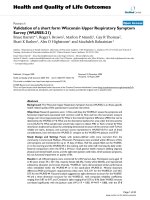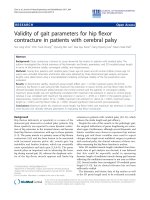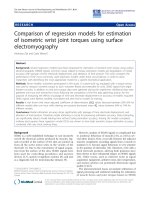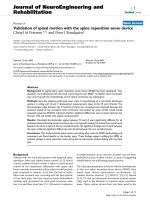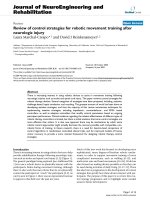báo cáo hóa học:" Review of fixation techniques for the four-part fractured proximal humerus in hemiarthroplasty" pdf
Bạn đang xem bản rút gọn của tài liệu. Xem và tải ngay bản đầy đủ của tài liệu tại đây (2.53 MB, 8 trang )
REVIEW Open Access
Review of fixation techniques for the four-part
fractured proximal humerus in hemiarthroplasty
Daniel Baumgartner
1*
, Betsy M Nolan
2
, Robert Mathys
3
, Silvio Rene Lorenzetti
4
and Edgar Stüssi
5
Abstract
Introduction: The clinical outcome of hemiarthroplasty for proximal humeral fractures is not satisfactory.
Secondary fragment dislocation may prevent bone integration; the primary stability by a fixation technique is
therefore needed to accomplish tuberosity healing. Present technical comparison of surgical fixation techniques
reveals the state-of-the-art approach and highlights promising techniques for enhanced stability.
Method: A classification of available fixation techniques for three- and four part fractures was done. The placement
of sutures and cables was described on the basis of anatomical landmarks such as the rotator cuff tendon
insertions, the bicipital groov e and the surgical neck. Groups with similar properties were categorized.
Results: Materials used for fragment fixation include heavy braided sutures and/or metallic cables, which are
passed through drilling holes in the bone fragments. The classification resulted in four distinct groups: A: both
tuberosities and shaft are fixed together by one suture, B: single tuberosities are independently connected to the
shaft and among each other, C: metallic cables are used in addition to the sutures and D: the fragments are
connected by short stitches, close to the fragment borderlines.
Conclusions: A plurality of techniques for the reconstruction of a fractured proximal humerus is found. The
categorisation into similar strategies provides a broad overview of present techniques and supports a further
development of optimized techniques. Prospective studies are necessary to correlate the technique with the
clinical outcome.
Introduction
Clinical background
Hemiarthroplasty represents an established treatment
method for three or four-part fractured proximal
humeri. Pain relief is often achieved by this surgical
intervention, but the functional result is less predictable
[1,2]. Consequently, clinical outcome scores are ranging
from bad-satisfact ory to good-excellent (Table 1). Com-
plicat ions such as non-union or resorpt ion of the tuber-
osity fragments occur in 30-70% of all cases [3-9].
Reasons for this poor outcome may be secondary displa-
cement which negatively affects the muscular balance at
the rotator cuff and predisposes the patient to worse
clinical results [10-14]. Tuberosity malposition also cor-
relates with fatty infiltration into the rotator cuff and
subsequent disuse of the shoulder function [15].
Different patient specific factors such as health status or
rehabilitation after surgery influence the result: Injury
related variables are predetermined such as the severity
of fracture dislocation, neurological deficits or the type
of fracture [16]. Although the optimisation of the
implant design is often discussed, a significant correla-
tion between a specific prosthesis type and patient satis-
faction was not observed [17]. Nevertheless, a significant
better Constant Score for one specific fragment fixation
technique (using additional cable to the suture fixation)
compared to the established technique of using sutures
was seen [18]. Other surgeons’ experie nces support the
findings that the fixation technique seems to be crucial
for tuberosity union and apparently represents one of
the most influencing factors for a good outco me
[19-22]. Furthermore, the grade of tuberosity dislocation
directly correlates with the clinica l outcome. It is there-
fore assumed that the prevention of fragment disloca-
tion by a stable fixation technique has a direct impact
on the clinical result [23].
* Correspondence:
1
Institute for Biomechanics, ETH Zurich, Wolfgang-Pauli Strasse 10, 8093
Zurich, Switzerland
Full list of author information is available at the end of the article
Baumgartner et al. Journal of Orthopaedic Surgery and Research 2011, 6:36
/>© 2011 Baumgartner et al; license e BioMed Central Ltd. This is an Open Access article distributed under the terms of the Creative
Commons Attribu tion Li cense ( which permits unrestricted use, distribution, and
reproduction in any medium, provided the original work is properly cited.
History of proximal humeral fracture fixation for
hemiarthroplasty
The first operation o f a shoulder replacement was per-
formed 1893 by Dr. Péan [24]. Horse hairs were used to
reattach the muscles to the predrilled holes in the pros-
thesis shaft. Themistocles Gluck ment ioned the fixation
of the prosthesis to the bone by different osteosynthesis
techniques. However, he did not further analyse the
fixation of the fragme nts in particular [25]. In t he mod-
ern era, techniques for proximal humeral fragment fixa-
tion were established by Neer et al, focussing on the
placement of the cables and sutures at the proximal
humerus [26]. Current fixation techniques correspond
to the appropriat e prosthesis designs and are therefore
primarily described in detail in the OP manuals of the
implant industry.
Published fixation techniques were often tested in a
biomechanical test to analyse s trength and stability. In
prior studies, different in-vitro loading profiles were
applied such as load-to-failure testing of fixation techni-
ques [27,28]. In other biomechanical tests, a torque was
introduced at the humeral bone which induced a rota-
tion around the humeral longitudinal axis to apply pas-
sive muscular tension [29,30]. A further investigation
used a numerical approach to mathem atically determine
the strength of the fixation by means of a Finite Element
Analysis [31]. These biomecha nical investigations show
that substantial efforts have been made to find an
appropriate and stable fixation technique for a four- part
fracture. Nevertheless, a comprehensive collection of
existing techniques is needed prior to biomechanical
testing.
A summary of existing fixation techniques may sup-
port the identification of f urther advantageous techni-
ques. By comparing the most frequent techniques,
promising features and innovative procedures may be
combined. Existing publications focus primarily on one
specific technique; it is therefore of interest to have a
direct comparison. Classifying the different techniques
in distinct groups supports a schematic innovation pro-
cess to develop novel techniques. The aim of this inves-
tigation is therefore the analysis of existing fixation
techniques for proximal humeral four-part fractures for
hemiarthroplasty.
Method of analyzing fixation techniques
A review of the different fixation techniques in the lit-
erature was carried out focusing on proximal humeral
four-part fractures. Suture and wire placement based on
illustrations from literature (Figure 1, left) was trans-
ferred in a standardised image demonstrating a restored
rotator cuff in anteriolateral view (Figure 1, right). Ana-
tomical landmarks at the proximal humerus such as the
bicipital groove, the surgical neck fracture line, tendon
insertions and the rotator cuff interval were used to
localise the suture configuration s and the placement on
the bone surface. For simplicity, all left shoulders have
been inverted to standardize all techniques to the right
shoulder. In our opinion, this procedure represents a
reliable method, as the mentioned anteriolateral v iew is
frequently used to represent performed fixation techni-
ques. The data recorded include:
- the number of strands connecting the humeral shaft
to the greater tuberosity;
Table 1 Postoperative results of proximal humeral fractures with respect to the Constant Score
Reference # cases Follow-up
[Mts]
Ø-Age
[Years]
Anat. Tuberosity healing Constant Score
Ambacher et al [32] 27 42 69 -65
Becker et al [33] 27 45 67 -45
Boileau et al [12] 66 27 66 -56
Boileau et al [34] 43 29 68 15 60
Bosch et al [1] 40 43 68 - 54.2
Boss et al [17] 20 32 77 -52
Christoforakis et al [35] 26 50 65 - 70.4
Demirhan et al [18] 32 35 58 26 68
Kollig et al [20] 46 62 60 -66
Kralinger et al [13] 167 29 70 90 55.4
Reuther et al [36] 56 39 71 28 46
Zyto et al [10] 36 12.4 72 - 57.5
Loew et al [25] 21 29.3 74.1 15 51.5
Mehlhorn et al [37] 26 17 70.3 -52
Grönhagen et al [19] 46 53 72 42
Baumgartner et al. Journal of Orthopaedic Surgery and Research 2011, 6:36
/>Page 2 of 8
- the number of strands connecting the humeral shaft
to the lesser tuberosity;
- the number of strands connecting the greater and
lesser tuberosity to each other;
- the number of strands connecting the greater and
lesser tuberosity to the shaft;
- the design of the middle parts of corresponding
prosthesis including
- the number of holes and fins in the proximal shaft
- the qualitative prosthesis shape
Conventions
A uniform terminology of suture placement was defined
that corresponds to the frequently used conventions in
literature: the strands oriented parallel/collinear to the
shaft axis were defined as longitudinal, leading from
proximal-to-distal. Circular strands were perpendicular
to the longitudinal axis of the humerus, placed circum-
ferentially around the cuff. Transverse sutures repre-
sented a placement through the prosthesis. Diagonal
sutures were guided from the GT-LT fragment to the
anterior-posterior diaphysis of the shaft. The use of
dotted lines represented transosseous sutures. Blue lines
represented a tuberosity connection to the shaft, and
green lines represented interfragmenta ry connections
between the LT and th e GT. Cerc lages around t he GT
and LT, guided through the prosthesis, are shown as
magenta, and metallic braided cables as black. S utures
interconnecting all three fragments like GT, LT and
shaft are shown as red.
Review
Several investigations have applied the figure-of-eight
technique by interconnecting all three fragments such as
the shaft, the GT and the LT [32-34]. Dines et al recom-
mended the attachment of t he tuberosities to the shaft,
to each other, and to the fin of the prosthesis (Table 2).
First the GT is secured to the shaft and to the fin of the
prosthesis using transverse sutures. Then the LT is fixed
to the shaft and to the GT. With the tuberosities now
secured to the prosthesis stem, a figure-of-eight tension
band is placed through the rotator cuff tendons near
their insertion into the tub erosities, and finally tied to
the proximal shaft. A longitudinal suture is used for an
additional fixation of the GT to the shaft. The posterior
longitudinal suture enters in the superior portion of the
supraspinatus tendon and is connected to the shaft.
Hence, the GT is secured to the shaft with a separate
suture.
Similar to the previous technique of Dines et al, t he
technique of Frankle et al uses the same prosthesis type
[35,22]. Both tuberosity fragments a re fixed to the mid-
dle part of the prosthesis. A circumferentially oriented
suture secures the tuberosities to each other: one end of
the suture captures the GT by placing i t through the
posterior rotator cuff, whereas the opposite end captures
the LT. The circumferential suture is first tied to fix the
tuberosities together. Drill holes are placed distally to
the surgical neck for reattachment of the tuberosities to
the shaft in a figure-of-eight technique. These longitudi-
nal sutures are then finally tied to secure the tuberos-
ities to the shaft. The Aequalis fracture prosthesis is
used in another curren t technique by Boileau et al [19].
Figure 1 Transfer of one published fixation technique (left, Dines et al) into a schematic representation (right) by using d escribed
anatomical landmarks. (Reproduced with permission of the author, Images copyright 2002, Joshua S. Dines. MD).
Baumgartner et al. Journal of Orthopaedic Surgery and Research 2011, 6:36
/>Page 3 of 8
Table 2 Schematic overview of performed fixation techniques and corresponding implant designs
Reference Graphics Prosthesis Fixation Technique
#
fins
# holes # of strands
GT-shaft
# of strands
LT-shaft
# of strands
LT-GT
# of strands LT-
GT Shaft
(Frankle and
Mighell 2004)
2
fins
No holes 1 1 2 0
Neer III , Smith&Nephew
Two internally placed augmentation sutures
Vertical cross-stitches
Dines 2002
Abrutyn 2003
2120
No remarks of implant type
Boileau OP-
Manual
No
fiSns
One
central
hole
0022
Aequalis, Tornier
Voigt 2007
2
fins
4 holes
each
1130
Two figures-of-eight tuberosities fixed at the head support.
Univers, Arthrex
Gerber OP-
Manual
No
fins
2 holes 1 1 2 0
Anatomical Fracture, Zimmer
Krause 2007
Hertel
No
fins
2 holes 0 0 1 2
Cable system for the entire fixation
Epoca, Synthes
Baumgartner et al. Journal of Orthopaedic Surgery and Research 2011, 6:36
/>Page 4 of 8
Two sutures are placed in the ISP and two in the Teres
Minor (TM) tendon. Reconstruction starts with the first
two of a total of four circular sutures. These are passed
around the prosthetic neck to fix the GT. Then the LT
is fixed by using the other two circular su tures. The two
lower sutures are subsequently fixed to the tendon
insertion to pull the rotator cuff distally and restore the
pretension on the rotator cuff tendons. Translational
and rotational tests have been performed to assess the
stability of fixation. Large-diameter (no. 5 or 7) non-
absorbable sutures were used to secure both tuberos-
ities. Circular and longitudinal sutures secure th e frag-
ments with respect to a potential multidirectional
muscle tension.
In contrast to the pre viously discussed fixation techni-
ques, both tuberosities may be fixed individually to the
shaft by separate figure-of-eight tension bands [36]. The
UniversprosthesisisusedinVoigt’ s description which
has lateral fins. Two holes are drilled in the posterior
and anterior humeral shaft to reduce each of the tuber-
osities. Three circular sutures are initially positioned
around the gre ater tuberosity and the prosthetic neck.
The lesser tuberosity is held by two sutures passed
through the anterior-medial holes of the prosthesis. The
circular sutures are first tied to pull down both tuberos-
ities into the anatomical position. A technique similar to
that of Voigt et al has been performed by Gerber et al.
[37]. In this technique using the Anatomical fracture
prosthesis (Zimmer Ltd), sutures are placed in both
tuberosities to pull them down to the shaft. This pros-
thesis design does not provide fins, which affords more
room proximally for tuberosity positioning.
First, the circular sutures connecting the tuberosity
fragments are tied, then the strands to the shaft are
tightened. A suture i s placed in a predrilled GT hole
and a second one in the LT hole. A cerclage suture is
passed through the SSC tendon, around the GT and the
LT and ends at the ISP and TM tendon insertion. A
suture in the humeral shaft, medial t o the bicipital
groove, pulls the distal end of the lesser tuberosity back
down to the shaft. Additional sutures in the middle of
the prosthesis are used for further reduction.
Reuther et al. use the Affinis fracture prosthesis
(Mathys Ltd) [38]. To achieve a better tuberosity fixa-
tion, the central part of the prosthesis is equipped with
two holes to insert non-absorbable sutures or cables.
The central part does not have any fins and is covered
by rough calcium phosphate coating. After pulling
through the sutures, the tuberosities are height -adjusted
and fixed with retention stitches to the outer edge of
the central part and o ver each other. Both tuberosities
are fixed to the stem by circumferential wiring. Finally,
the circular compression cable (grey) is closed.
In the technique of Hertel et al, fixati on consists only
of metallic cables, without using sutures [39]. This
method is applied together with the Epoca prosthetic
system (Synthes GmbH, Switzerland), which has a rec-
tangular shaft design including two anteroposterior
holes, but no fins. Two horizontal w ires connect the
fragments to the prosthesis. The titanium cables are
pulled by a tensioner and closed by a clamp mechanism.
A tension-band technique using braided polyester
sutures has been use d for biomechanic al testing [28]
using the Epoca prosthesis. The tuberosities are fixed to
the rim of the prosthetic head via sutures passed
through the tendon-to-bone junction. In addition, the
tuberosities are sutured to each other and to the hum-
eral diaphysis. Circular, transosseous sutures connect
both tuberosities. The tuberosities are fixed to the dia-
physis with longitudinal single-loop sutures.
Table 2 Schematic overview of performed fixation techniques and corresponding implant designs (Continued)
Reuther 2008 No
fins
2 holes 1 1 2 0
Cable system around the GT-LT prosthesis
Affinis Fracture, Mathys Medical
Beutler De Wilde,
Poster
No
fins
3 holes 1 1 2 1
Epoca, Synthes
Baumgartner et al. Journal of Orthopaedic Surgery and Research 2011, 6:36
/>Page 5 of 8
Similar fixation technique has also been applied to the
humerus reconstruction without using an implant [40].
Such configurations are also applicable for hemiarthro-
plasty and were therefore considered too. The study
shows a treatment for a four-part, valgus impacted frac-
ture. Tuberosities are secured t o each other and to the
medial and lateral side of the diaphysis in a cruciate
fashion. Anot her two pairs of sutures are inserted later-
ally and medially through drill holes in the diaphysis.
These sutures are guided into the opposite tuberosity,
near the musculotendinous junction. Each suture is tied
individually and then to each other in a cruciat e
arrangement.
Stability was investigated in a biomechanical test for
three different fixation techniques by Abu Rajab et al
[27]. The monobloc Neer prosthesis design with two lat-
eral fins and four suture-wire holes was used. In the first
technique, both tuberosities were attached to the shaft
and to each other, each with separate sutures. In the
second technique, an additional cerclage is placed
through the medial fin. Biomechanical testing revealed
that an additional cerclage does not enhance the stabi-
lity but that the stability was significantly reduced if the
tuberosities were not fixed to each other.
Metallic wires are also used for a figure-of-eight ten-
sion band technique [41]. The anterior wire fixes the
lesser tuberosity and the attached subscapularis muscle,
the superior one passes through the supraspinatus ten-
don and around the great er tuberosity back to the shaft.
Whereas Wijgman et al placed the cerclage wires as
close to the tendon insertions as possible, others prefer
a transosseous placement of the cable through the
tuberosities [42-44]. This difference results from two
philosophies: wires may have a negative influence on the
periosteal blood supply, particularly in a vascular area
such as the rotator cuff.
Recent hemi arthroplasty treatments are using a modi-
fied prosthesis’ middle part. Schittko et al propose a
middle part with multiple h oles for an unconstrained
placement of the tuberosities using the Ortra prosthesis
[45]. A further method of tuberosity reconstruction is
presented by Sosna et al [46], where humeral plating
and hemiarthroplasty is combined. A screw inserted into
a proximal plate (fixed to the prosthesis), through the
tuberosities into the prosthesis middle shaft provides
primary fragment stability. A summary of all descr ibed
techniques is given in Table 2.
Results
Based on the analysis in the review, four groups of dif-
ferent fixation techniques are built. Each group sum-
marises therefore a similar strategy of fixation:
Group A: Tub erosities and shaft are connected by one
single suture. In group A, Dines et al and Frankle et al
use a figure-of-eight tension band over the entire surface
of the rotator cuff to connect all three fragments such as
the humeral shaft, the GT and the LT.
Group B: The single tuberosities are independently
connected to the shaft an d among each other: In group
B, Voigt et al and Gerber et al use the figure-of-eight ten-
sion band to connect only single fragments indepen-
dently to the stem, without involving all three fragments.
Voigt et al, Boileau et al and Reuther et al place several
sutures ranging from the SSC to the ISP tendon insertion
and additionally apply a tension-band technique between
the LT and the GT in a horizontal orientation.
Group C: Metallic cables are used in addition to the
sutures: Reuther et al, De Wilde et al and Hertel et al
use metallic cables either applied alone or in combina-
tion with sutures. The cables are often placed circumfer-
entially around the shaft humeral shaft.
Group D: Short suture loops are used to connect adja-
cent fragments together. The suture loops are placed
close to their fragment borderlines.
Discussion & Conclusion
Recently, the fixation tech nique of proximal humeral
four-part fractures is often discussed in literature. The
number of acquired references demonstrates the high
relevance in fixing humeral proximal four-part fractures.
Generally, securing tuberosity fragments against med-
ial displacement is done by horizontal sutures, circum-
ferentially around the cuff. The sutures are passed
around the prosthesis a nd the humeral long bone in
form of a closed-loop. A similar placement is done for
the metallic cables. No anchor in the b one is therefore
needed, since two suture/cable ends are fixed together
by knots.
Placement of stable sutures along the hu meral axis on
the bone surface - connecting the shaft to single tuber-
osities - seems to be more challenging: Drilling holes
are needed in the shaft and in the fragments as anchor
points. The effect of cutting-out of sutures through the
bone has to be expected. Due to the fact that proximal
fragme nt displacement is seen clinically, the scenario of
a cutting effect has to be assumed. Further studies dis-
cuss a fixation of sutures at the proximal humeral shaft
without using drilling holes [47]
To be able to strengthen proximal-to-distal tuberosity-
to-shaft connections, a placement of a cable along the
humeral axis would be of interest. Connecting two cir-
cumferential oriented cables ( one placed around the
fragments, one around the shaft) by another cable pre-
sumably leads to enhanced stiffness [48] (Figure 2).
Baumgartner et al. Journal of Orthopaedic Surgery and Research 2011, 6:36
/>Page 6 of 8
Further prospective studie s are necessary to correlate
specific techniques with the clinical outcome. A standar-
dised, biomechanical testing strategy according to phy-
siological loads is needed toevaluatethestrengthof
such techniques.
List of abbreviations
LT: Lesser Tuberosity; GT: Greater Tuberosity; SSP: Supraspinatus; ISP:
Infraspinatus; SSC: Subscapularis; TM: Teres Minor.
Author details
1
Institute for Biomechanics, ETH Zurich, Wolfgang-Pauli Strasse 10, 8093
Zurich, Switzerland.
2
50 N Illinois St 817, Indianapolis, IN 46204, USA.
3
RMS
Foundation, Bischmattstrasse 12, 2544 Bettlach, Switzerland.
4
Institute for
Biomechanics, ETH Zurich, Wolfgang-Pauli Strasse 10, 8093 Zurich,
Switzerland.
5
Institute for Biomechanics, ETH Zurich, Wolfgang Pauli Str. 10,
8093 Zurich, Switzerland.
Authors’ contributions
DB as the main author was responsible for the preparation of the
manuscript.
The technical analysis of existing fixation techniques was provided by BN,
RM and SL. ES is the head of the department and approved the strategic
background of present publication. All authors read and approved the final
manuscript.
Competing interests
The authors declare that they have no competing interests.
No fees or funding was received from a commercial partner.
Received: 8 March 2010 Accepted: 18 July 2011 Published: 18 July 2011
References
1. Goldman RT, et al: Functional outcome after humeral head replacement
for acute three- and four-part proximal humeral fractures. J Shoulder
Elbow Surg 1995, 4(2):81-6.
2. Stableforth PG: Four-part fractures of the neck of the humerus. J Bone
Joint Surg Br 1984, 66(1):104-8.
3. Bosch U, et al: Outcome after primary and secondary hemiarthroplasty in
elderly patients with fractures of the proximal humerus. J Shoulder Elbow
Surg 1998, 7(5):479-84.
4. Hartsock LA, et al: Shoulder hemiarthroplasty for proximal humeral
fractures. Orthop Clin North Am 1998, 29(3):467-75.
5. Hasan SS, et al: Characteristics of unsatisfactory shoulder arthroplasties. J
Shoulder Elbow Surg 2002, 11(5):p. 431-41.
6. Hawkins RJ: Displaced proximal humeral fractures. Orthopedics 1993,
16(1):49-53.
7. Kraulis J, Hunter G: The results of prosthetic replacement in
fracturedislocations of the upper end of the humerus. Injury 1976,
8(2):129-31.
8. Tanner MW, Cofield RH: Prosthetic arthroplasty for fractures and
fracturedislocations of the proximal humerus. Clin Orthop Relat Res 1983, ,
179: 116-28.
9. Zyto K, Kronberg M, Brostrom LA: Shoulder function after displaced
fractures of the proximal humerus. J Shoulder Elbow Surg 1995, 4(5):331-6.
10. Agorastides I, et al: Early versus late mobilization after hemiarthroplasty
for proximal humeral fractures. J Shoulder Elbow Surg 2007, 16(3 Suppl):
S33-8.
11. Boss AP, Hintermann B: Primary endoprosthesis in comminuted humeral
head fractures in patients over 60 years of age. Int Orthop 1999,
23(3):172-4.
12. Demirhan M, et al: Prognostic factors in prosthetic replacement for acute
proximal humerus fractures. J Orthop Trauma 2003, 17(3):181-8; discussion
188-9.
13. Gronhagen CM, et al
: Medium-term
results after primary
hemiarthroplasty for comminute proximal humerus fractures: a study of
46 patients followed up for an average of 4.4 years. J Shoulder Elbow
Surg 2007, 16(6):766-73.
14. Kollig E, et al: [Primary hemiarthroplasty after complex fracture of the
humeral head–functional late results]. Zentralbl Chir 2003, 128(2):125-30.
15. Greiner SH, et al: Tuberosity position correlates with fatty infiltration of
the rotator cuff after hemiarthroplasty for proximal humeral fractures. J
Shoulder Elbow Surg 2009, 18(3):431-6.
16. Robinson CM, et al: Primary hemiarthroplasty for treatment of proximal
humeral fractures. J Bone Joint Surg Am 2003, 85-A(7):1215-23.
17. Loew M, et al: Influence of the design of the prosthesis on the outcome
after hemiarthroplasty of the shoulder in displaced fractures of the head
of the humerus. J Bone Joint Surg Br 2006, 88(3):345-50.
18. Fialka C, et al: Primary hemiarthroplasty in four-part fractures of the
proximal humerus: randomized trial of two different implant systems. J
Shoulder Elbow Surg 2008, 17(2):210-5.
19. Boileau P, et al: Tuberosity malposition and migration: reasons for poor
outcomes after hemiarthroplasty for displaced fractures of the proximal
humerus. J Shoulder Elbow Surg 2002, 11(5):401-12.
20. Dines DM, Warren RF: Modular shoulder hemiarthroplasty for acute
fractures. Surgical considerations. Clin Orthop Relat Res 1994, , 307: 18-26.
21. Hoffmeyer P: The operative management of displaced fractures of the
proximal humerus. J Bone Joint Surg Br 2002, 84(4):469-80.
22. Mighell MA, et al: Outcomes of hemiarthroplasty for fractures of the
proximal humerus. J Shoulder Elbow Surg 2003, 12(6):569-77.
Figure 2 Anchoring cables by bone washers according to Baumgartner et al (left) or placement of sutures circumferential ly around
the proximal humeral shaft, Pijls et al (middle and right).
Baumgartner et al. Journal of Orthopaedic Surgery and Research 2011, 6:36
/>Page 7 of 8
23. Kralinger F, et al: Outcome after primary hemiarthroplasty for fracture of
the head of the humerus. A retrospective multicentre study of 167
patients. J Bone Joint Surg Br 2004, 86(2):217-9.
24. Lugli T: Artificial shoulder joint by Pean (1893): the facts of an
exceptional intervention and the prosthetic method. Clin Orthop Relat Res
1978, , 133: 215-8.
25. Bankes MJ, Emery RJ: Pioneers of shoulder replacement: Themistocles
Gluck and Jules Emile Pean. J Shoulder Elbow Surg 1995, 4(4):259-62.
26. Neer CS: 2nd,Displaced proximal humeral fractures. II. Treatment of
three-part and four-part displacement. J Bone Joint Surg Am 1970,
52(6):1090-103.
27. Abu-Rajab RB, et al: Re-attachment of the tuberosities of the humerus
following hemiarthroplasty for four-part fracture. J Bone Joint Surg Br
2006, 88(11):1539.
28. De Wilde LF, et al: A new prosthetic design for proximal humeral
fractures: reconstructing the glenohumeral unit. J Shoulder Elbow Surg
2004, 13(4):373-80.
29. Frankle MA, et al: Stability of tuberosity reattachment in proximal
humeral hemiarthroplasty. J Shoulder Elbow Surg 2002, 11(5):413-20.
30. Williams GR, et al: The influence of intramedullary fixation on figure-of-
eight wiring for surgical neck fractures of the proximal humerus: a
biomechanical comparison. J Shoulder Elbow Surg 1997, 6(5):423-8.
31. Baumgartner D, et al: Refixation stability in shoulder hemiarthroplasty in
case of four-part proximal humeral fracture. Med Biol Eng Comput 2009,
47(5):515-22.
32. Dines D: Hemiarthroplasty for Complex Four-Part Fracture of the
Proximal Humerus: Technical Considerations and Surgical Technique. The
University of Pennsylvania Orthopaedic Journal 2002, 15:29-36.
33. Abrutyn : Secure Tuberosity Fixation in Shoulder Arthroplasty for
Fractures. Techniques in Shoulder and Elbow Surgery 2004, 5(4):177-183.
34. Siegel JA, Dines DM: Techniques in managing proximal humeral
malunions. J Shoulder Elbow Surg 2003, 12(1):69-78.
35. Frankle MA, Mighell MA: Techniques and principles of tuberosity fixation
for proximal humeral fractures treated with hemiarthroplasty. J Shoulder
Elbow Surg 2004, 13(2):239-47.
36. Voigt C, Lill H: [Primary hemiarthroplasty in proximal humerus fractures].
Orthopade 2007, 36(11):1002-12.
37. Gerber C: Operation Manual of Anatomical Shoulder Fracture. Operation
manual, Zimmer Ltd 2005.
38. Reuther F, Muller S, Wahl D: Management of humeral head fractures with
a trauma shoulder prosthesis: correlation between joint function and
healing of the tuberosities. Acta Orthop Belg 2007, 73(2):179-87.
39. Krause FG, Huebschle L, Hertel R: Reattachment of the tuberosities with
cable wires and bone graft in hemiarthroplasties done for proximal
humeral fractures with cable wire and bone graft: 58 patients with a 22-
month minimum follow-up. J Orthop Trauma 2007, 21(10):682-6.
40. Dimakopoulos P, Panagopoulos A, Kasimatis G: Transosseous suture
fixation of proximal humeral fractures. J Bone Joint Surg Am 2007,
89(8):1700-9.
41. Wijgman AJ, et al: Open reduction and internal fixation of three and
four-part fractures of the proximal part of the humerus. J Bone Joint Surg
Am 2002, 84-A(11):1919-25.
42. Lin JS, et al: Effectiveness of replacement arthroplasty with calcar
grafting and avoidance of greater tuberosity osteotomy for the
treatment of humeral surgical neck nonunions. J Shoulder Elbow Surg
2006, 15(1):12-8.
43. Nho SJ, et al: Innovations in the management of displaced proximal
humerus fractures. J Am Acad Orthop Surg 2007, 15(1):12-26.
44. Ruter A: [Indication and technique for shoulder endoprostheses in
fractures]. Chirurg 2001, 72(11):1246-52.
45. Schittko A, Braun W, Ruter A: [Experiences with the OrTra-prosthesis in
primary prosthetic replacement of fractures of the humeral head–
indication, technique and results]. Zentralbl Chir 2003, 128(1):12-6.
46. Sosna A, et al: A new technique for reconstruction of the proximal
humerus after three- and four-part fractures. J Bone Joint Surg Br 2008,
90(2):194-9.
47. Pijls B, Werner P, Eggen P: Alternative humeral tubercle fixation in
shoulder hemiarthroplasty for fractures of the proximal humerus.
Congress Abstract Book 2008, SECEC 2008, Poster No. 105, Brugge, Belgum.
48. Baumgartner D, et al: Primary stability testing of novel refixation strategies in
case of a proximal humeral four-part fracture Swiss Medical forum,
Supplementum 173, Swiss Society of Orthopedics and Traumatology SGO,
Geneva; 2009, 139.
doi:10.1186/1749-799X-6-36
Cite this article as: Baumgartner et al.: Review of fixation techniques for
the four-part fractured proximal humerus in hemiarthroplasty. Journal of
Orthopaedic Surgery and Research 2011 6:36.
Submit your next manuscript to BioMed Central
and take full advantage of:
• Convenient online submission
• Thorough peer review
• No space constraints or color figure charges
• Immediate publication on acceptance
• Inclusion in PubMed, CAS, Scopus and Google Scholar
• Research which is freely available for redistribution
Submit your manuscript at
www.biomedcentral.com/submit
Baumgartner et al. Journal of Orthopaedic Surgery and Research 2011, 6:36
/>Page 8 of 8


